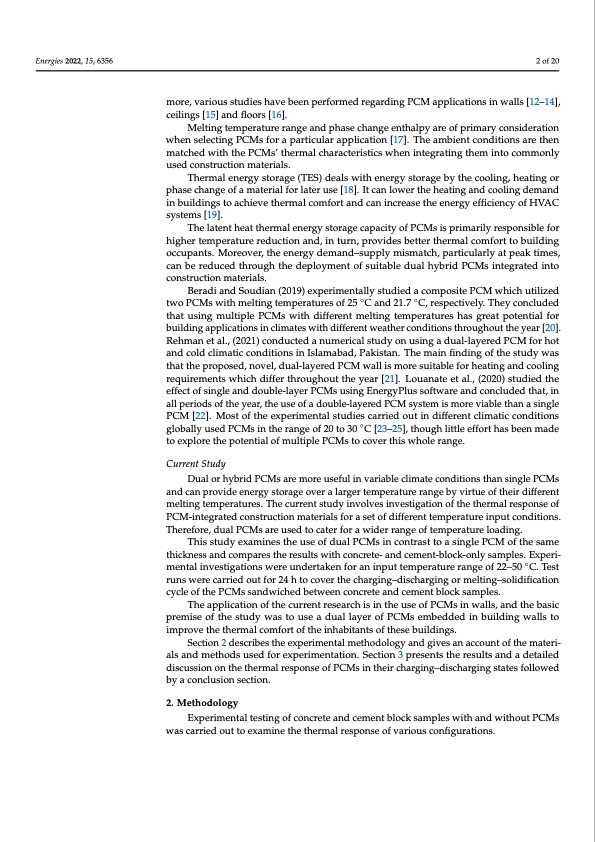
PDF Publication Title:
Text from PDF Page: 002
Energies 2022, 15, 6356 2 of 20 more, various studies have been performed regarding PCM applications in walls [12–14], ceilings [15] and floors [16]. Melting temperature range and phase change enthalpy are of primary consideration when selecting PCMs for a particular application [17]. The ambient conditions are then matched with the PCMs’ thermal characteristics when integrating them into commonly used construction materials. Thermal energy storage (TES) deals with energy storage by the cooling, heating or phase change of a material for later use [18]. It can lower the heating and cooling demand in buildings to achieve thermal comfort and can increase the energy efficiency of HVAC systems [19]. The latent heat thermal energy storage capacity of PCMs is primarily responsible for higher temperature reduction and, in turn, provides better thermal comfort to building occupants. Moreover, the energy demand–supply mismatch, particularly at peak times, can be reduced through the deployment of suitable dual hybrid PCMs integrated into construction materials. Beradi and Soudian (2019) experimentally studied a composite PCM which utilized two PCMs with melting temperatures of 25 ◦C and 21.7 ◦C, respectively. They concluded that using multiple PCMs with different melting temperatures has great potential for building applications in climates with different weather conditions throughout the year [20]. Rehman et al., (2021) conducted a numerical study on using a dual-layered PCM for hot and cold climatic conditions in Islamabad, Pakistan. The main finding of the study was that the proposed, novel, dual-layered PCM wall is more suitable for heating and cooling requirements which differ throughout the year [21]. Louanate et al., (2020) studied the effect of single and double-layer PCMs using EnergyPlus software and concluded that, in all periods of the year, the use of a double-layered PCM system is more viable than a single PCM [22]. Most of the experimental studies carried out in different climatic conditions globally used PCMs in the range of 20 to 30 ◦C [23–25], though little effort has been made to explore the potential of multiple PCMs to cover this whole range. Current Study Dual or hybrid PCMs are more useful in variable climate conditions than single PCMs and can provide energy storage over a larger temperature range by virtue of their different melting temperatures. The current study involves investigation of the thermal response of PCM-integrated construction materials for a set of different temperature input conditions. Therefore, dual PCMs are used to cater for a wider range of temperature loading. This study examines the use of dual PCMs in contrast to a single PCM of the same thickness and compares the results with concrete- and cement-block-only samples. Experi- mental investigations were undertaken for an input temperature range of 22–50 ◦C. Test runs were carried out for 24 h to cover the charging–discharging or melting–solidification cycle of the PCMs sandwiched between concrete and cement block samples. The application of the current research is in the use of PCMs in walls, and the basic premise of the study was to use a dual layer of PCMs embedded in building walls to improve the thermal comfort of the inhabitants of these buildings. Section 2 describes the experimental methodology and gives an account of the materi- als and methods used for experimentation. Section 3 presents the results and a detailed discussion on the thermal response of PCMs in their charging–discharging states followed by a conclusion section. 2. Methodology Experimental testing of concrete and cement block samples with and without PCMs was carried out to examine the thermal response of various configurations.PDF Image | PCM-Integrated Building Construction

PDF Search Title:
PCM-Integrated Building ConstructionOriginal File Name Searched:
energies-15-06356-v2.pdfDIY PDF Search: Google It | Yahoo | Bing
Turbine and System Plans CAD CAM: Special for this month, any plans are $10,000 for complete Cad/Cam blueprints. License is for one build. Try before you buy a production license. More Info
Waste Heat Power Technology: Organic Rankine Cycle uses waste heat to make electricity, shaft horsepower and cooling. More Info
All Turbine and System Products: Infinity Turbine ORD systems, turbine generator sets, build plans and more to use your waste heat from 30C to 100C. More Info
CO2 Phase Change Demonstrator: CO2 goes supercritical at 30 C. This is a experimental platform which you can use to demonstrate phase change with low heat. Includes integration area for small CO2 turbine, static generator, and more. This can also be used for a GTL Gas to Liquids experimental platform. More Info
Introducing the Infinity Turbine Products Infinity Turbine develops and builds systems for making power from waste heat. It also is working on innovative strategies for storing, making, and deploying energy. More Info
Need Strategy? Use our Consulting and analyst services Infinity Turbine LLC is pleased to announce its consulting and analyst services. We have worked in the renewable energy industry as a researcher, developing sales and markets, along with may inventions and innovations. More Info
Made in USA with Global Energy Millennial Web Engine These pages were made with the Global Energy Web PDF Engine using Filemaker (Claris) software.
Sand Battery Sand and Paraffin for TES Thermo Energy Storage More Info
| CONTACT TEL: 608-238-6001 Email: greg@infinityturbine.com | RSS | AMP |